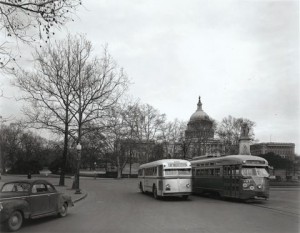Secretary Foxx has issued his direction that Metro cannot consider any new rail expansion right now, and WMATA agrees! So much so that we wrote it into our strategic plan back in 2013. Earlier this fall, the Prince William County’s Board of Supervisors heard from WMATA about the importance of fixing Metro’s core before considering any expansion.

The Silver Line’s Phase 2 extension from Wiehle-Reston East to Dulles Airport and Loudoun County could be the last for decades to come. (photo credit: Ryan Stavely, Flickr)
As the region grows, so does the pressure for extensions of Metrorail. The requests are frequent and common: “Extend Metro to BWI! to Centreville! to Waldorf! to Fort Belvoir!” We’ve heard and even modeled most of these requests. For a system that’s shaped and contributed tremendous economic value to the region, it only makes sense that communities outside of its immediate reach want improved access to it. WMATA Director of Planning Shyam Kannan recently took the opportunity to discuss the potential for the extension of Metrorail into Prince William County. With 80% of today’s Metrorail trips going to or through the system’s core (PDF), he noted that major core capacity improvements must be made prior to considering any additional rail extensions. While addressing core capacity has been a major part of Momentum, including initiatives like the 8-car train program, core stations, and New Blue Line Connections, the plan remains largely unfunded. With safety and state of good repair needs as Metro’s top priorities and core capacity relief put off indefinitely, any potential extensions (if they happen) are likely decades away from being built.
Read more…
Categories: Strategies Tags: BRT, commuter rail, core capacity, corridors, expansion, land use, LRT, Metro 2025, Metrorail, Momentum, policy, Streetcar, tod, transit-oriented development
Transit expansion is in demand but Metrorail, light rail, and other high capacity transit projects can be expensive to build, operate and maintain. With limited resources to invest, our region must ensure that these projects serve the most robust transit markets and are supported by strong transit friendly policies.
Informed by our peers and local performance measures, Metro is developing guidelines that the region can use to inform development of high capacity transit projects. As we’ve explored previously, there’s much more to transit expansion than Metrorail. In fact, due to the cost associated with Metrorail expansion along with existing land uses and built environment in much of the region, most of our future high capacity transit projects will be made up of other transit modes. But what is the best way to decide what mode best fits each corridor? The goal of the expansion guidelines is to inform those decisions.

Development in Arlington’s Rosslyn-Ballston Corridor has validated initial and ongoing investments in Metrorail. (source: Arlington County)
A literature and peer review included policy documents from BART (PDF), the Bay Area Metropolitan Transportation Commission, Florida DOT, Virginia DRPT, Federal Transit Administration (PDF), and research from the University of California Transportation Center (UCTC). The review found that ridership, density, the presence of walkable streets and sidewalks, local plans and policies, and cost effectiveness are the most relevant criteria to evaluate transit projects and that rigorous performance targets are needed to support each transit mode. Read more…
Categories: ConnectGreaterWashington Tags: BART, BRT, corridors, DRPT, Light Rail, Metrorail, plans, ridership, Streetcars, tod, transit-oriented development
New Metro study evaluates best practices for the coordination of bus service with new, street-running rail services.

What’s old is new again! Capital Transit vehicles sharing the road in 1947.
In the Washington region, bus rapid transit (BRT), light rail transit (LRT) and streetcar (SC) systems are currently under study or construction on major transit corridors in every jurisdiction. Each is being planned by a different agency with different sets of goals and aspirations. Most of these corridors currently are already served by Metrobus and have heavy bus ridership. All of these projects can leave a bus planner wondering how all of these modes will work together and with the existing Metrobus system.
Some existing riders will be fully served by the new service; however, many others will require a combination of existing bus service and the new fixed route transit to reach their final destinations. As transit professionals, the ability for our customers to navigate seamlessly though the region via transit, regardless of the mode or operator, is our ultimate goal. Towards that end, we have been working on a set of guidelines for the operations planning of buses and new modes traveling in the same corridors. Read more…





Recent Comments